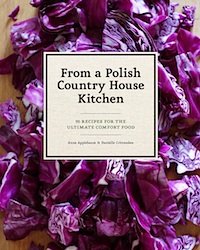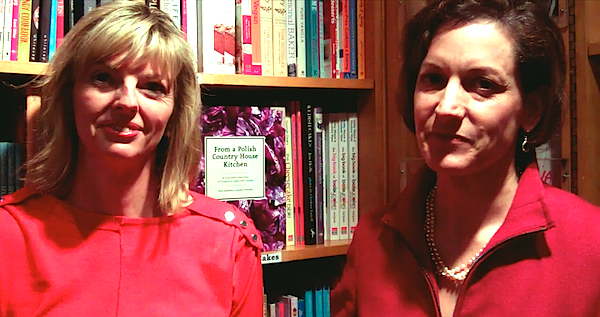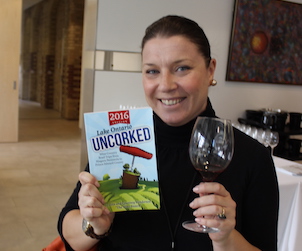 The authors of From a Polish Country Kitchen have rather accomplished author-journalist day jobs. Anne Applebaum is the author of Gulag: A History, for which she was awarded the 2004 Pulitzer Prize for General Non-Fiction, and has just published Iron Curtain: The Crushing of Eastern Europe, 1944-1956 to rave reviews. Danielle Crittenden is the International Blog Editor for The Huffington Post (where, full disclosure, she recruited me as a blogger). Both, too, are respectively one half of a serious power couple. Crittenden is married to political strategist and columnist David Frum and Applebaum is married to Poland’s Minister of Foreign Affairs, Radosław Sikorski, with whom she shares the country house and its kitchen. The two couples are good friends and the genesis of the cookbook came from meals they have shared from the Polish country house’s kitchen over the years.
The authors of From a Polish Country Kitchen have rather accomplished author-journalist day jobs. Anne Applebaum is the author of Gulag: A History, for which she was awarded the 2004 Pulitzer Prize for General Non-Fiction, and has just published Iron Curtain: The Crushing of Eastern Europe, 1944-1956 to rave reviews. Danielle Crittenden is the International Blog Editor for The Huffington Post (where, full disclosure, she recruited me as a blogger). Both, too, are respectively one half of a serious power couple. Crittenden is married to political strategist and columnist David Frum and Applebaum is married to Poland’s Minister of Foreign Affairs, Radosław Sikorski, with whom she shares the country house and its kitchen. The two couples are good friends and the genesis of the cookbook came from meals they have shared from the Polish country house’s kitchen over the years.
I caught up with Applebaum and Crittenden at their Canadian book launch at Toronto’s Cookbook Store, hosted by Frum and attended by a cross section of active and retired politicians, journalists, academics and even a few of the wine makers and growers who neighbour Frum and Crittenden’s own country house in Prince Edward County. In the video below, Applebaum and Crittenden describe the genesis of the book, how Polish cuisine is making a resurgence as the nation recovers from decades of hard times and why the cookbook is meeting an unsatiated hunger for Polish recipes in North America – among other things. We also discussed “little doves” or cabbage rolls, the excerpted recipe for which is below.
Can’t see the video? Click here.
GoŁĄbki : “Little Doves,” or Cabbage Rolls
 There is a reason why this dish is called gołąbki in Polish, which means “little doves.” Although cabbage rolls can be too heavy and too filling, when they are made correctly they distinctly resemble delicate cabbage birds, nestled in a wild mushroom sauce or a simply enhanced broth. Like zrazy (stewed beef rolls) or stuffed chicken breasts (see page 148), they are made with the humblest and simplest of ingredients, yet they are elegant enough for any reasonably festive occasion. When all twenty-seven European foreign ministers met for a celebratory dinner in a fabulous villa in the Old Town of Gdansk, the Polish hosts served tiny cabbage rolls, stuffed with buckwheat kasha, as a first course.
There is a reason why this dish is called gołąbki in Polish, which means “little doves.” Although cabbage rolls can be too heavy and too filling, when they are made correctly they distinctly resemble delicate cabbage birds, nestled in a wild mushroom sauce or a simply enhanced broth. Like zrazy (stewed beef rolls) or stuffed chicken breasts (see page 148), they are made with the humblest and simplest of ingredients, yet they are elegant enough for any reasonably festive occasion. When all twenty-seven European foreign ministers met for a celebratory dinner in a fabulous villa in the Old Town of Gdansk, the Polish hosts served tiny cabbage rolls, stuffed with buckwheat kasha, as a first course.
In truth, little doves are closely related to the stuffed grape leaves of Greece, and they ought to be thought of in the same way: A little bit of flavorful, spicy meat or mushrooms wrapped up in something green, with a light, creamy sauce drizzled on top. Serve the gołąbki with a side salad and you have a wonderfully healthful, comforting supper. Arrange them on a platter and you have an exotic appetizer for a dinner party or an addition to a buffet. Allow one or two stuffed cabbage leaves per person for an appetizer and three for a main course.
Cabbage Rolls with Wild Mushroom Stuffing in Tomato Broth
Serves 6 as an appetizer, or 4 as a main course (makes 16 rolls)
2 large heads savoy cabbage
One 1-oz/30-g package dried mixed wild mushrooms or porcini
2 cups/480 ml boiling water
7 tbsp/100 g unsalted butter
2 tbsp minced onion
1 lb/455 g mixed fresh wild mushrooms, cleaned (see Note), trimmed, and coarsely chopped
2⁄3 cup/70 g dry bread crumbs
Salt and freshly ground pepper
2 medium plum tomatoes, sliced into thin rounds
1 tsp tomato paste
1 cup/225 g canned crushed tomatoes
Splash of chicken broth or white wine, if needed
Cooked rice for serving (optional)
Preheat the oven to 350ºF/180°C/gas 4.
Fill a large pot – one in which you can submerse a whole head of cabbage – with water and bring to a boil. (It is helpful to use a pot with a strainer insert, such as a pasta pot, so you can pick up the insert to remove the cooked cabbage, rather than struggle with spoons or tongs.) Add the first head of cabbage and parboil for about 10 minutes. Remove and let it drain in a colander in the sink until just cool enough to handle. Meanwhile, cook the second head of cabbage, drain, and cool.
Gently pull the outer leaves off each cabbage. (Some of these might be soggy or torn.) Set these aside to line the baking dish. It helps to cut off some of the coarse stem at the beginning and while peeling off the leaves. Your goal is to have 12 to 16 perfect medium to large leaves in which to roll the stuffing. Set aside the small leaves for lining the baking dish as well. If you can get more than 16 leaves to stuff, do so—you can never have too many little doves. Pat each leaf dry and set aside on a kitchen or paper towel.
Soak the dried mushrooms in the boiling water for at least 30 minutes, until softened. Strain the soaking liquid through a fine-mesh strainer lined with a paper towel or cheesecloth, placed over a bowl. Set the liquid aside. Squeeze the mushrooms until the juices are all extracted. Rinse the mushrooms with cold water, pat dry, and coarsely chop.
Melt 2 tbsp of the butter in a large frying pan over medium heat, and cook the onion until translucent. Add the chopped fresh and dried mushrooms and continue to cook until all the mushrooms are soft and golden, 5 to 10 minutes, stirring often.
Pour the cooked mushroom mixture into a food processor and add the bread crumbs, a large pinch of salt, and a few grinds of pepper and process until well chopped and integrated, but not mushy.
Lay out the “choice” cabbage leaves on a work surface and divide the filling among the leaves: The exact portion size for each one will depend on the size of the leaf. (I dollop the filling on with a tablespoon, placing it near the bottom of the leaf). If any stem remaining on the leaf seems especially tough or thick, you can pare it down with a vegetable peeler. Roll the leaves up, folding in the sides and ends so the stuffing is enclosed.
Line the bottom of a 9-x-12-in/23-x-30.5-cm baking dish with any leftover cabbage leaves. (If, after lining the dish, you find you still have a lot of leftover leaves, store them in the refrigerator and eventually chop them, cook in butter, and season with salt and pepper to serve as a side dish for another meal!). Rest the rolls on top, seam-side down; they can be crowded together, just so long as they don’t overlap. If you run out of room in one baking dish, start a smaller, second one, lining it the same way.
In a small saucepan, bring the reserved mushroom soaking liquid to a low boil. Whisk in the tomato paste and, when incorporated, the crushed tomatoes. Allow to boil for a minute or two, until slightly reduced and thickened. Pour over and around the cabbage rolls. The tomato broth should just come just up the sides of the rolls, but not submerge them. If there is not enough broth, top off with a little chicken broth or even dry white wine. Dot the cabbage rolls with 3 tbsp of the butter. Bake for 40 minutes to 1 hour, or until the tops are golden and slightly crispy.
Remove the rolls to a warm platter, with the cooked tomato slices still on top. Pour the broth into a small saucepan, bring to a boil, and whisk in the remaining 2 tbsp butter. Reduce until the broth is slightly thickened and silky, and adjust the seasoning. Pour the sauce over the rolls and serve immediately. Because these “little doves” do not have rice in them, they can be served along with a side of cooked rice for a more hearty meal.
NOTE: To clean wild mushrooms, use the edge of the blade of a paring knife to scrape off the thin outer layer of dirt, or use a soft vegetable brush. Mushrooms aren’t usually washed as that makes them hard to dry, and they also deteriorate more quickly.
 Malcolm Jolley is a founding editor of Good Food Revolution and Executive Director of Good Food Media, the not-for-profit corporation which publishes it. Follow him at twitter.com/malcolmjolley
Malcolm Jolley is a founding editor of Good Food Revolution and Executive Director of Good Food Media, the not-for-profit corporation which publishes it. Follow him at twitter.com/malcolmjolley








